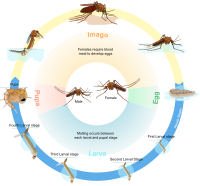
Photo from wikipedia
Multicellularity has evolved several independent times over the past hundreds of millions of years and given rise to a wide diversity of complex life. Recent studies have found that large… Click to show full abstract
Multicellularity has evolved several independent times over the past hundreds of millions of years and given rise to a wide diversity of complex life. Recent studies have found that large differences in the fundamental structure of early multicellular life cycles can affect fitness and influence multicellular adaptation. Yet, there is an underlying assumption that at some scale or categorization multicellular life cycles are similar in terms of their adaptive potential. Here, we consider this possibility by exploring adaptation in a class of simple multicellular life cycles of filamentous organisms that only differ in one respect, how many daughter filaments are produced. We use mathematical models and evolutionary simulations to show that despite the similarities, qualitatively different mutations fix. In particular, we find that mutations with a tradeoff between cell growth and group survival, i.e. “selfish” or “altruistic” traits, spread differently. Specifically, altruistic mutations more readily spread in life cycles that produce few daughters while in life cycles producing many daughters either type of mutation can spread depending on the environment. Our results show that subtle changes in multicellular life cycles can fundamentally alter adaptation. Author summary Early forms of multicellular organisms exhibit a wide range of life cycles. Though studies have explored how the structure of a life cycle determines the fitness of early multicellular organisms, far less is known about how it affects their adaptation. Studies that do investigate adaptation typically focus on large scale differences between life cycles, implicitly assuming that at some scale life cycles are similar in terms of their adaptation. In this study we consider this assumption by analyzing adaptation in a class of early multicellular life cycles where the only difference between them is the number of offspring they produce. We use mathematical models and evolutionary simulations to compute the fate of mutations that are either altruistic or selfish, depending on their effects on single cells and the groups to which they belong. We find that despite the similarity between life cycles they can adapt very differently. In particular, life cycles that produce few offspring consistently adapt via altruistic traits, while life cycles that produce many offspring adapt via either altruistic or selfish traits depending on the environment. Ultimately, we find that small scale differences in multicellular life cycles can have large effects on adaptation.
Journal Title: PLOS Computational Biology
Year Published: 2022
Link to full text (if available)
Share on Social Media: Sign Up to like & get
recommendations!